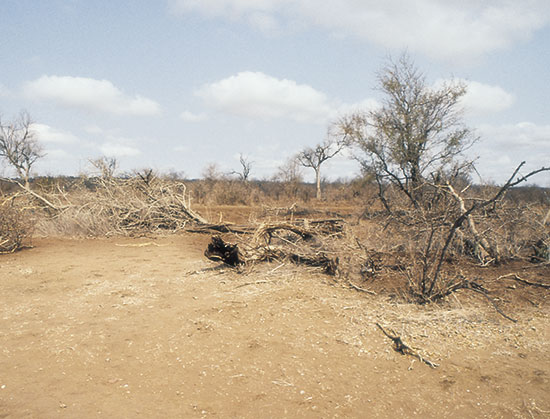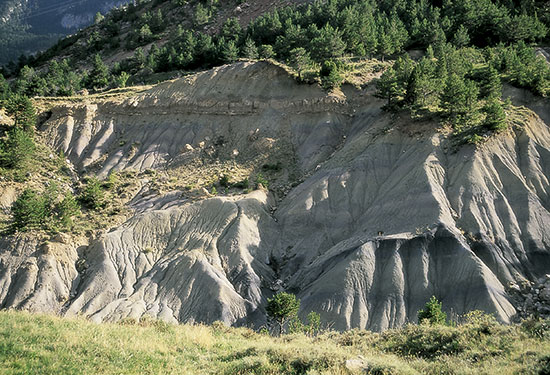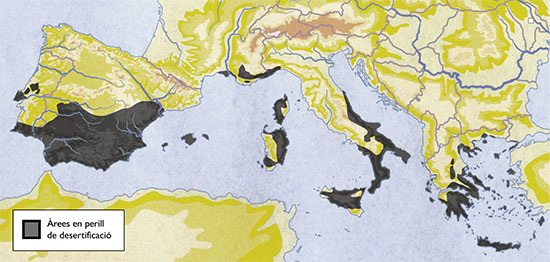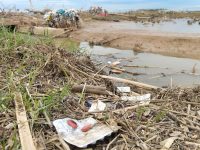
|
Between 1925 and 1975, the Sahara desert grew, especially southward, about 645,000 km2, and in some parts of Sudan, the southern boundary of the desert moved 310,000 km2 between 1958 and 1975. This development was most important in the sixties and early seventies, due to periods of severe drought that affected the Sahel areaPhoto: A. Masó Desertification processes in the context of global change. Desertification, the degradation of the soils in arid, semiarid and sub-humid zones, threatens 40% of the Earth’s surface, which is inhabited by 37% of the world’s population. The effects of desertification are varied, and include not only a decrease in the food production capacity of the soils, but also the alteration of the hydrological cycle, a drastic reduction in biodiversity, and their interaction with climatic change. In this article the author discusses these effects, and the efforts of the international community to fight against desertification. Approximately 40% of the Earth’s surface is threatened by the risk of desertification. On this surface, which is one of the terrestrial areas with more or less pronounced inherent water deficits, lives 37% of the world’s population. Desertification threatens not only the potential of the soil to produce food and biomass; moreover, in the affected areas, hydrologic cycles are altered, biodiversity is drastically reduced and feedback processes occur that affect important climate parameters. In the context of global change, the consequences of desertification processes are exported to other areas not directly affected and cause many transectoral consequences. Among other aspects, we should note the impacts in wildlife migration movements, changes in atmospheric energy flows, the effects on the erosion/sedimentation dynamics, the changes in biogeochemical cycles and the human migrations caused by the impoverishment of land resources. Therefore, desertification threatens the entire biosphere potential of the affected areas and it has cross-border and multisectoral effects that directly have an impact on global change. In this article we will describe the immediate background of this problem, and the efforts of the international community to mitigate the process. Finally we will discuss its interactions with biodiversity loss and climate change. BACKGROUND The concept and problems of desertification are not new. Land abuse and the consequent degradation processes in fragile areas of the world are linked to the beginnings of the great civilisations. Historical records of the Middle East, ancient Greece and the Roman Empire show evidence of great historical value that describes in detail environmental impacts and processes that led to the collapse of agroforestry areas. Several authors have considered this situation as the cause of the sharp decline of some cultures. However, the term “desertification” does not appear in scientific literature until 1949, when it was used by Aubreville to refer to processes of soil and vegetation degradation in humid tropical environments. Thereafter, and with intervals and fluctuations in academic attention, it evolved far from public perception. The problem of desertification would only jump to the fore as a result of the intense periods of drought that affected the Sahel area in the late sixties and early seventies. During that period, economies and production systems of survival, based primarily on the use of land and water, were impacted by an overpressure that placed them on the edge of their dysfunctionality. As a consequence, it is estimated that about five hundred million hectares were affected and that about 10 million head of livestock and between one hundred and two hundred thousands people died. The global awareness of this situation mobilised the UN, who convened in 1977 a Convention to Combat Desertification held in Nairobi that year and in which an environmental problem was considered globally for the first time. In this convention, attended by over 90 countries, a Plan of Action to Combat Desertification (PACD) was developed and adopted with very broad and ambitious approaches and objectives. However, the assessment of the results of the PACD years later did not provide grounds for optimism. The extent and intensity of desertification were not reduced; on the contrary, they continued to spread. This contributed, in part, to the loss of strength and interest of the topic for international organisations, development aid agencies and potential donor countries in the 80s. Added to this is the situation of conceptual confusion in academic and scientific fields, since each discipline brought their own definitions, which obviously did not help establish a solid foundation for the proper discussion of the problem. In 1990-91, the United Nations Environment Programme (UNEP) took up the issue by convening analysis and review groups to achieve a better approach to the problem. The result was to adapt the conceptual framework with a new and more explicit definition and to identify more appropriately the causal relationships and the basic guidelines to address solutions. In the Rio Summit held in 1992, this new definition established in 1991 was amended to include, along with human causes, the natural vulnerability of the affected areas. With this, the definition incorporated the aspect of «climate variability» as one of the root causes in the origin of the process. THE UN CONVENTION TO COMBAT DESERTIFICATION The issue of desertification was widely discussed at the United Nations Conference on Environment and Development (UNCED, Rio de Janeiro 1992), although its consideration did not reach the emphasis and attention given to the problems of biodiversity loss or the threat of climate change. In any case, in 1993, at the 47th session of the General Assembly of the United Nations, the resolution 47/188 was adopted setting out the United Nations’ commitment to the «establishment of an intergovernmental negotiating committee for the elaboration of an international convention to combat desertification in those countries experiencing serious drought and/or desertification, particularly in Africa». The first meeting of the intergovernmental committee created for this purpose was held in Nairobi that year. The first part of the conference was devoted mainly to present the situation of the countries affected by desertification processes, allowing to know the extent of the problem in global terms, as well as its variability and complexity. In the second part of the meeting, a draft work plan for the development of the Convention was drawn up, and it was agreed that actions had to be prioritised in African countries, while still taking under consideration the proposals for action aimed at other countries and regions affected by desertification processes. Thus began a process that ended in Paris in 1994 with the drafting and official presentation of the “United Nations Convention to Combat Desertification” (from now on, UNCCD). The UNCCD was officially launched on 26 December 1996, ratified by 70 countries, including Spain. The Convention, with its 40 articles and four regional annexes, is basically oriented towards the overall goal to «to combat desertification and mitigate the effects of drought» and sets out new strategies in international law on the environment. Annex IV sets out the general plan of action for the Mediterranean basin. A very important aspect contained in this Annex is the commitment of the countries affected by desertification processes to develop their own national plan to combat desertification. Responsibility that, in our country, falls initially on the Directorate-General for Nature Conservation, of the Ministry of Environmental Affairs. Definitions of the Convention a) “desertification” means land degradation in arid, semi-arid and dry sub-humid areas resulting from various factors, including climatic variations and human activities; b) “combating desertification” includes activities which are part of the integrated development of land in arid, semi-arid and dry sub-humid areas for sustainable development which are aimed at: c) “drought” means the naturally occurring phenomenon that exists when precipitation has been significantly below normal recorded levels, causing serious hydrological imbalances that adversely affect land resource production systems; d) “mitigating the effects of drought” means activities related to the prediction of drought and intended to reduce the vulnerability of society and natural systems to drought as it relates to combating desertification; e) “land” means the terrestrial bio-productive system that comprises soil, vegetation, other biota, and the ecological and hydrological processes that operate within the system; f) “land degradation” means reduction or loss, in arid, semi-arid and dry sub-humid areas, of the biological or economic productivity and complexity of rainfed cropland, irrigated cropland, or range, pasture, forest and woodlands resulting from land uses or from a process or combination of processes, including processes arising from human activities and habitation patterns, such as: g) “arid, semi-arid and dry sub-humid areas” means areas, other than polar and sub-polar regions, in which the ratio of annual precipitation to potential evapotranspiration falls within the range from 0.05 to 0.65. Summary of the Convention The text of the Convention includes forty articles in six sections: Developed countries must support the preparation of national action programmes and help implement specific measures identified in the national programmes. The Secretariat of the Convention is an independent entity based in Bonn (Germany) responsible, among other tasks, for the organisation of international meetings, the gathering and dissemination of information, and the facilitation of urgent action for Africa. The Conference of the Parties (COP) is the highest decision-making body of the Convention. The COP has also established a Science and Technology Committee composed of government representatives competent in the various fields relevant to desertification. The COP has a panel of independent experts who are consulted to work on specific issues. Desertification in the european mediterranean The Northern Mediterranean region is a complex mosaic of diverse landscapes. Much of the region is semi-arid and is subject to seasonal droughts, high rainfall variability or sudden intense downpours. It is characterised by the continued exploitation of its land for more than 8,000 years, its high density of population, intensive agricultural production, large industrial concentrations, being a major tourist destination… We should also add the terrible escalation of forest fires that in the period from 1976 to 1999, and especially in Valencia, swept two-thirds of its forest area. The United Nations estimated in 1991 that erosion destroys every year between 0.2 and 0.5% of farmlands worldwide. However, at the same time land degradation progressed by leaps and bounds, global food production continued to increase thanks to the combination of the use of fertilizers, irrigation expansion and the emergence of new more productive varieties of cereals, advances that have masked the effects of soil erosion and degradation.Photo: B.Borrell The degradation of lands in the Mediterranean is often related to inadequate agricultural practices or the use of marginal areas unsuitable in principle for agriculture. Under these conditions, the soil is eroded, loses organic matter, salinization increases and its production capacity gradually decreases in response to this combination of natural hazards – droughts, floods, forest fires – and to the aforementioned human activities. The socioeconomic changes and the situation of crisis and neglect that traditional agriculture has faced these last years aggravate this situation, with the consequent migrations from rural to urban areas. Excessive use of pesticides, fertilizers, poorly planned irrigation and industrial and urban pollution are undermining the long-term health of the soils of the region. The dramatic and sustained growth of economic activities along the Mediterranean coast, such as the entertainment industry, tourism, intensive agriculture and other industrial activities, are imposing unusual stress to these areas, particularly with regard to the water regime, which is accentuating the risks of salinization. Geographical distribution of the areas vulnerable to desertification in Mediterranean Europe (YASSOGLOU, N.: “Soil Degradation and Desertification”. RUBIO et al. (Eds.): Key Notes of the Third International Congress of the European Society for Soil Conservation “Man and Soil at the Third Millennium”. Valencia, 28 March – 1 April, 2000. 133-144).
[Full article available in Catalan and Spanish] References José Luis Rubio. Chairman of the European Society for Soil Conservation (ESSC); Desertification Research Centre – CIDE (CSIC, University of Valencia, Generalitat Valenciana). |
|








